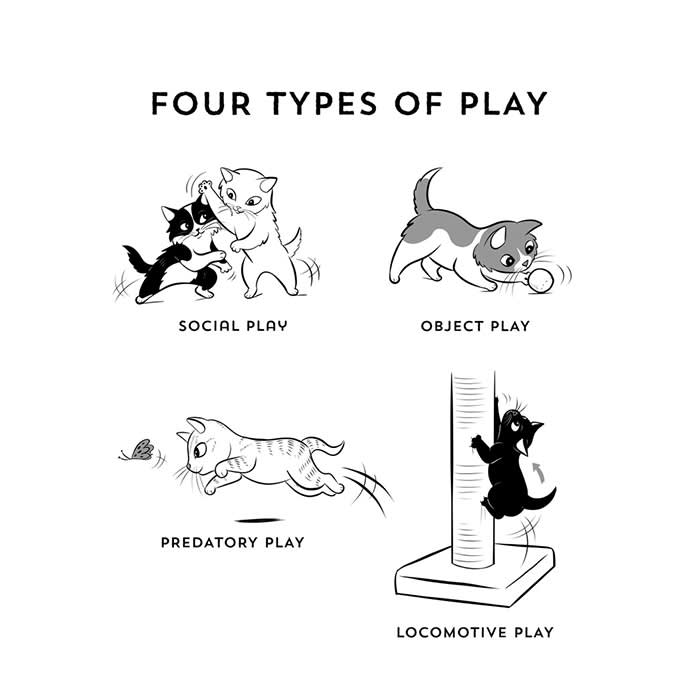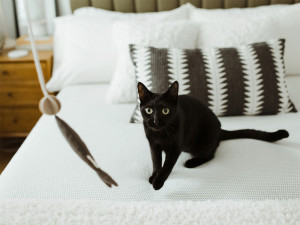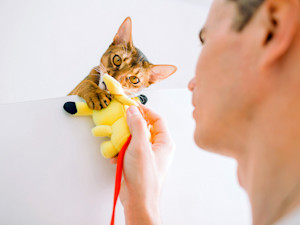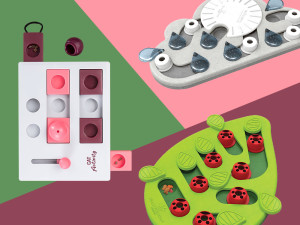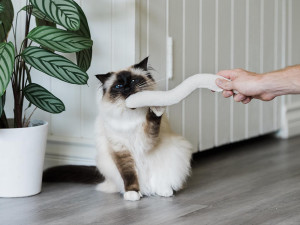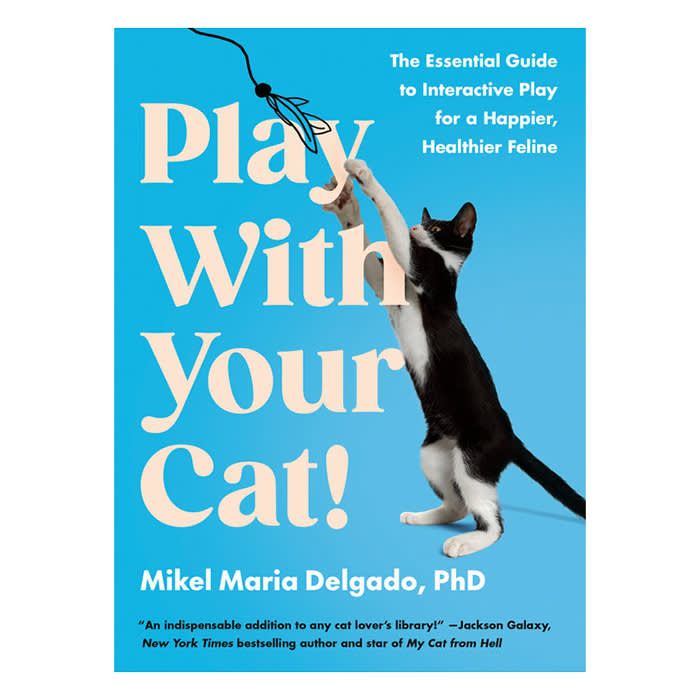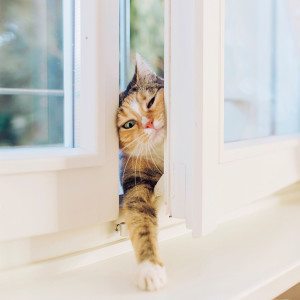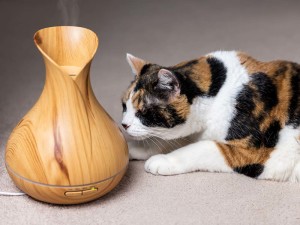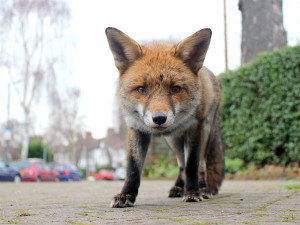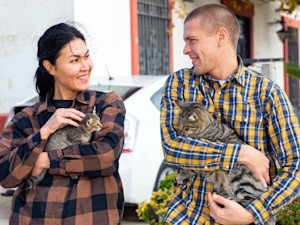Your Cat Really Wants You to Play With Them – Here’s How
It’s the key to a happy cat
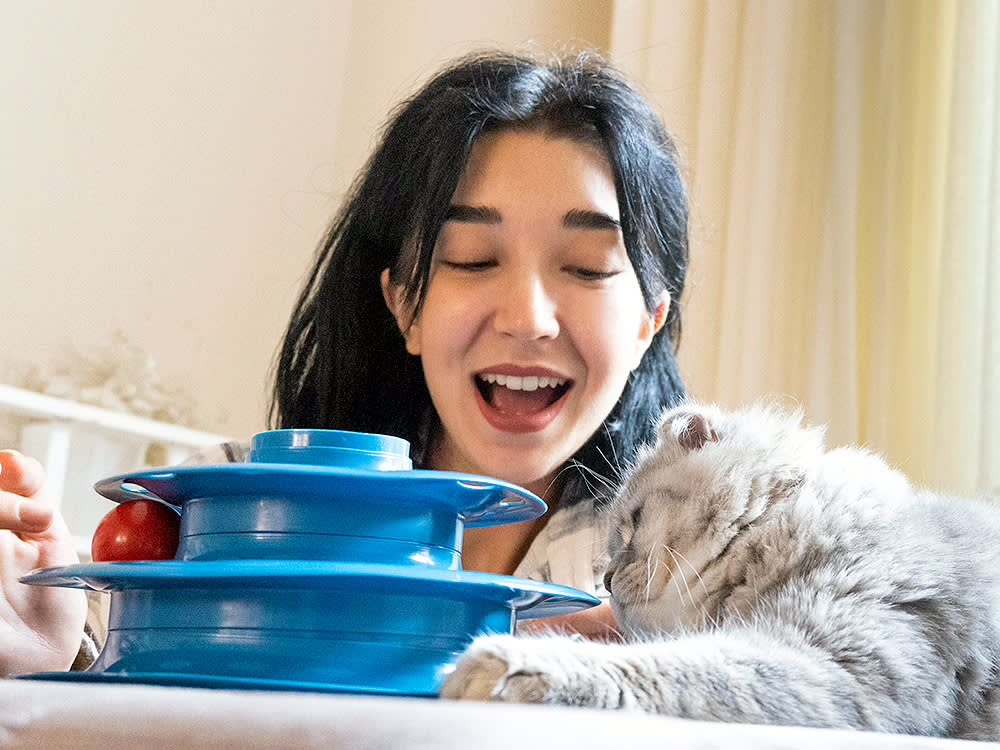
Share Article
Mikel Delgado describes herself as a ‘playful person’. She loves puzzles, games and making art and music. In fact, when Kinship Zoomed with the animal behaviourist and cat behaviour consultantopens in new tab, a drum set was in clear view behind her. So, as a cat expert, it’s no surprise that play and frivolity is top of mind for Mi, who wrote the bookopens in new tab How to Play With Your Cat: The Essential Guide to Interactive Play for a Happier, Healthier Feline.
“As a scientist, I was doing work that was related to different forms of enrichment in cats including play,” she tells us. “I wrote a scientific review of play behaviouropens in new tab in cats and was thinking it would be really cool to translate this to your average cat owner, so it’s not all full of stuffy language and citations but actually distill it into something useful.”
Delgado certainly achieved what she set out to do: How to Play With Your Cat is a fun, accessible (and yes, playful!) guide for cat parents that explores the four types of cat play: locomotive, predatory, object play and social play. Cat parents will also be disabused of any assumptions that cats can just be left to their own (literal) devices – looking at you, electronic toys. While Delgado says there is a place for interactive tech, such as iPad mouse games, it’s crucial to remember that your cat needs one-on-one play with you and with other cats, especially when they are kittens.
“I do think that people don’t think of play as important as the other stuff,” Delgado says. “Just scoop the litter box and toss some food down, and they’re fine. We really ignore the social interactions with cats that they need and thrive off of and also the mental stimulation and exercise component.”
She goes on to say that play is “just as important as having something to scratch. It’s just as important as giving them access to cat food. It’s just as important as giving them clean places to poo and pee – things that are very natural and instinctive to them.”
Below, Delgado tells us why play should be top of mind for new pet parents (and how to train those overly enthusiastic paws to bat at a kicker to instead of a human hand).
This interview has been edited for accuracy and clarity.
Why should new cat parents read this book?
From my experience working with new cat parents through my behavioural consulting service and at the shelter, I heard again and again from people that they did not play with their cats: “Oh, he doesn’t like to play.” I saw this potential issue where either people didn’t understand how to play with their cats, or they didn’t recognise play in their cats, or they didn’t know how to play.
To me, a natural antidote to that is encouraging play and activity in our cats. Just like when we exercise, we get an endorphin rush, and it kind of takes our mind off our problems. I want people to do the same thing with our cats. I saw an opportunity to really help people help their cats and have a better relationship with their cat, reduce the prevalence of behaviour problems, but also just make their cat happier. Let’s give cats some fun.
Why is it so important to start your cats playing when they’re young?
Play should happen throughout a cat’s life, but cats need play a lot more when they’re younger because one: they have a lot more energy. Two: they’re at a stage where they’re perfecting their life skills, so they have a lot more drive to basically chase anything that moves. Really, when I deal with clients who have recently adopted a kitten, nine times out of 10, they’re complaining that the cat is ‘too wild’. Climbing on the curtains, jumping on their hands and feet.
These things are natural because of their phase of life, but one thing is we don’t want to establish bad habits in kittens. It’s really important to play with so that they don’t get in the habit of seeking out hands and feet and eyelashes as something to bat at and pounce on.
How should you respond when a kitten bats at your hands or feet?
There’s often a conflict, because we want to pet the kitten because the kitten is soft and cute, and the kitten’s feeling a little bit wild. So, they might not be in the mood for petting; they may want to play instead. I usually recommend letting the cat approach you for petting, or pet the cat when they seem a little more relaxed.
And if you pet them, and they seem a little worked up, than either leave them alone or switch to play. So, you could switch to an interactive toy, or if they’re trying to bite and kick your hand, you can switch to a kicker toy. So, you can be like, “Oh, you’re in that kind of mood; let’s give you this instead.”
What is the biggest misunderstood assumption about cat’s play habits?
The biggest thing is that people understand what I call solo-play toys for their cats, [like little mice, balls, and springs]. But they’re not understanding the connection between them moving the toy and truly giving their cat an outlet for that hunting behaviour. Because if you’re a cat hunting, you’re not pushing the mouse around and then chasing the mouse like you are with the little mouse toy.
In the case of hunting, the prey is animated; the prey is living and moving. When we are playing the puppet master, we’re moving the toy. We’re taking away some of the predictability, so that’s more like prey would behave. The solo-play toys are important and fun, especially for kittens, but that’s not the key type of play that cats really benefit from, which is really mimicking the hunting experience through interactive play.
What do people need to know about their kitten’s play habits specifically?
People also don’t know how much play kittens need when they’re young. They’re bananas. They can play all day without getting exhausted, which is why I recommend getting kittens in pairs because then they can play with each other, so that’s the social play. The social play is the earliest observed in kittens.
At most rescue centres, you can’t get a kitten before 8–12 weeks. So, a lot of the early play with kittens starts at homes, when they’re with mum, in their litter. They’re going to start playing with their littermates as soon as they can open their eyes, and they’re gonna start wiggling around.
That’s when social play begins and then it kind of peaks at around four months of age. Most kittens go into a home during that period of high social play, and if they’re going into the home alone, then won’t have that companion for social play.
How can you keep your kitten safe when they’re playing with small things as they don’t seem threatening?
Anything with strings, wires, something that you should be holding in your hand when you’re playing with your cat, needs to be put completely away when you’re not around. As for small items, we don’t want to use anything they can choke on, so ping-pong balls are usually safe. Wine corks are usually safe. You what to observe your kitten with toys; you want to be aware of anything with ribbons and strings they could chew off or weird little eyeballs they could chew off.
So, I do recommend that people observe and think, Is there anything that could fall off? The safest toys have the fewest bells and whistles. So, I like toilet paper rolls cut up into smaller bits and ping-pong balls or things about that size or bigger without dangling parts on them.

Hilary Weaver
Hilary Weaver is the senior editor at Kinship. She has previously been an editor at The Spruce Pets, ELLE, and The Cut. She was a staff writer at Vanity Fair from 2016 to 2019, and her work has been featured in Esquire, Refinery 29, BuzzFeed, Parade, and more. She lives with her herding pups, Georgie and Charlie.
Related articles
![A man sitting on the floor with a woman lying in his lap holding a shit and grey cat in her arms in the air.]()
How to Move House With Your Cat
Who is more stressed, you or your feline?
![Tabby cat trying to open with her head window in order to enter the house.]()
Has a Cat Wandered Into Your Life? It Could Be the Cat Distribution System
TikTok thinks the universe just provides you a cat – is that really a thing?
![Calico cat sniffing wooden bamboo essential oil diffuser]()
Why Essential Oils and Cats Don’t Mix
How to keep your DIY spa cat-friendly
![A fox stares down the camera on a UK street.]()
Cats and Foxes: Friend or Foe?
A veterinary nurse and cat behaviourist explains the relationship between foxes and cats
![woman holding tabby kitten smiles at man holding tabby cat]()
How to Introduce Your Adult Cat to a New Kitten
Whether you have a friendly feline or a senior sourpuss, it’s important to help your cat adjust to a new kitten in the house

